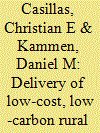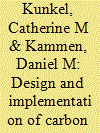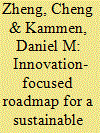|
|
|
Sort Order |
|
|
|
Items / Page
|
|
|
|
|
|
|
| Srl | Item |
| 1 |
ID:
107625


|
|
|
|
|
| Publication |
2011.
|
| Summary/Abstract |
The provision of both electrical and mechanical energy services can play a critical role in poverty alleviation for the almost two billion rural users who currently lack access to electricity. Distributed generation using diesel generators remains a common means of electricity provision for rural communities throughout the world. Due to rising fuel costs, the need to address poverty, and consequences of global warming, it is necessary to develop cost efficient means of reducing fossil fuel consumption in isolated diesel microgrids. Based on a case study in Nicaragua, a set of demand and supply side measures are ordered by their annualized costs in order to approximate an energy supply curve. The curve highlights significant opportunities for reducing the costs of delivering energy services while also transitioning to a carbon-free electrical system. In particular, the study demonstrates the significant cost savings resulting from the implementation of conventional metering, efficient residential lighting, and electricity generation using renewable energy sources.
|
|
|
|
|
|
|
|
|
|
|
|
|
|
|
|
| 2 |
ID:
101418


|
|
|
|
|
| Publication |
2011.
|
| Summary/Abstract |
An important concept in discussions of carbon management policies is cap and dividend, where some fraction of the revenues of an auction on emission allowances is returned to citizens on an equal per capita basis. This policy tool has some important features; it emphasizes the fact that the atmosphere is a common property resource, and it is a highly transparent measure that can be effectively used to protect the income of low-income individuals. In this paper we examine this policy in the California context, and focus on the costs and impacts of a cap and dividend scheme when applied to carbon emissions associated with electricity, natural gas and transportation services. We find that cap and dividend can effectively be used to address the economic impacts of carbon management policies, making them progressive for the lowest-income members of society. We find that the majority of households receive positive net benefits from the policy even with the government retaining half of the auction revenue. If auction revenues are instead dedicated only to low-income households, the majority of low-income households can be fully compensated even with the state government retaining upwards of 90% of auction revenues for other purposes.
|
|
|
|
|
|
|
|
|
|
|
|
|
|
|
|
| 3 |
ID:
128347


|
|
|
|
|
| Publication |
2014.
|
| Summary/Abstract |
The solar photovoltaic (PV) industry has undergone a dramatic evolution over the past decade, growing at an average rate of 48 percent per year to a global market size of 31 GW in 2012, and with the price of crystalline-silicon PV module as low as $0.72/W in September 2013. To examine this evolution we built a comprehensive dataset from 2000 to 2012 for the PV industries in the United States, China, Japan, and Germany, which we used to develop a model to explain the dynamics among innovation, manufacturing, and market. A two-factor learning curve model is constructed to make explicit the effect of innovation from economies of scale. The past explosive growth has resulted in an oversupply problem, which is undermining the effectiveness of "demand-pull" policies that could otherwise spur innovation. To strengthen the industry we find that a policy shift is needed to balance the excitement and focus on market forces with a larger commitment to research and development funding. We use this work to form a set of recommendations and a roadmap that will enable a next wave of innovation and thus sustainable growth of the PV industry into a mainstay of the global energy economy.
|
|
|
|
|
|
|
|
|
|
|
|
|
|
|
|
| 4 |
ID:
094254


|
|
|
|
|
| Publication |
2010.
|
| Summary/Abstract |
An analytical job creation model for the US power sector from 2009 to 2030 is presented. The model synthesizes data from 15 job studies covering renewable energy (RE), energy efficiency (EE), carbon capture and storage (CCS) and nuclear power. The paper employs a consistent methodology of normalizing job data to average employment per unit energy produced over plant lifetime. Job losses in the coal and natural gas industry are modeled to project net employment impacts. Benefits and drawbacks of the methodology are assessed and the resulting model is used for job projections under various renewable portfolio standards (RPS), EE, and low carbon energy scenarios We find that all non-fossil fuel technologies (renewable energy, EE, low carbon) create more jobs per unit energy than coal and natural gas. Aggressive EE measures combined with a 30% RPS target in 2030 can generate over 4 million full-time-equivalent job-years by 2030 while increasing nuclear power to 25% and CCS to 10% of overall generation in 2030 can yield an additional 500,000 job-years.
|
|
|
|
|
|
|
|
|
|
|
|
|
|
|
|
| 5 |
ID:
073234


|
|
|
|
|
|
|
|